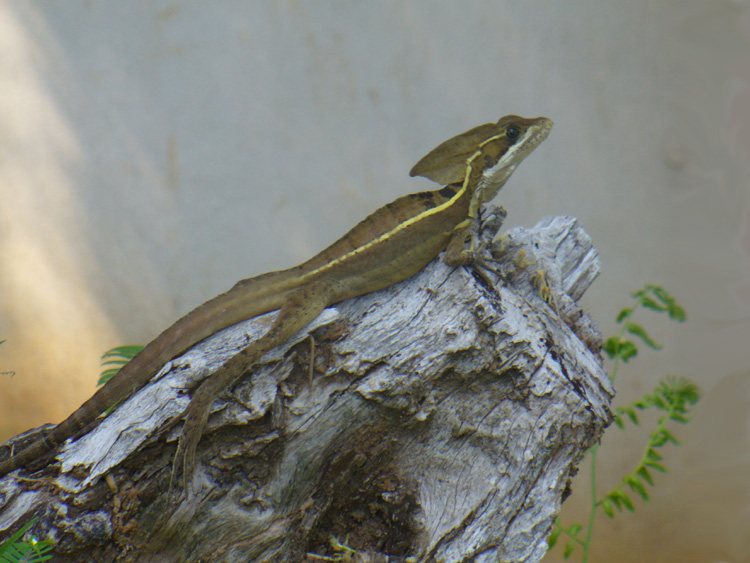
Basilisk
(Basiliscus vittatus)

Geographic Range
Basiliscus vittatus is native to Latin America. The picture on the left is a Yellow Striped Basilisk. It is found from Central Mexico southward to northern Colombia. Just recently it has been introduced to Florida. In Guatemala, this species is widespread, found practically anywhere where there is a water source.
Habitat
This species can be found in tropical and subtropical wet, moist, and dry forests. It occurs in dense vegetation along the margin of practically any body of water.
Physical Description
Males may slightly exceed 2 feet in total length, whereas females are considerably smaller (Bartlett 1999). Adult males have a large flaplike crest that is supported by flexible cartilage and projects from the back of the head to the neck. They also have a crest that extends from above their shoulders to about the level of the hind legs (Campbell 1998). The females have a folded "hood" outlining the back of the head and a lower vertebral crest than the males (Bartlett 1999). The head is large and males have a more elongate snout than the females. The tails and limbs are long and slender, the toes have a distinctive series of scales that form a fringe on each side, and the tail is laterally compressed. This is an unmistakable, gangly, brown lizard. Basilisks can both hop and run swiftly. They are able to run over still water when they are startled. Both males and females are dark-barred dorsally and have variably distinct yellowish dorsolateral lines. The lips and venter are light. Young specimens are particularly prominently patterned
Reproduction
Breeding interval
Striped basilisks breed once yearly.
Number of offspring3 to 12
Gestation period55 to 65 days
Age at sexual or reproductive maturity (female)3 to 12 months
Age at sexual or reproductive maturity (male)3 to 12 months
Sexual maturity is reached at about 9 to 10 cm. at less than a year of age, and during the wet season it has been estimated that hatchlings may reach sexual maturity in as little as three months. Females lay 3 to 12 eggs from May to August in a secluded moisture retaining nesting site, usually a hole along a canal bank. The young hatch during the early part of the rainy season from June to September in about 55 to 65 days.
Parental investment:
Females choose a safe nest site for their eggs. After laying the eggs there is no further parental care.Behavior
This lizard is quite arboreal, and can be seen in bushes and the lower branches of trees or thickets, but also spends time on the ground. At night it can be found sleeping in vine-covered thickets or in the open on low bushes. This is an alert, agile, speed-demon of a lizard. They are difficult to approach and even harder to photograph. Basilisks are capable of climbing, running, and swimming, all with equal facility. Adult males are particularly wary and may often be heard crashing to safety through the underbrush.
Food Habits
Striped basilisks feed mostly on insects but are reported to sometimes feed on fallen berries
Primary Diet:
insectivoreAnimal Foods:
insects; terrestrial non-insect arthropods.Plant Foods:
fruit.Predation
The brown basilisk relies mainly on alertness and speed to avoid predators, but may lash its tail vigorously if caught.
Other Comments
Because of this lizards ability to run across water in short distances, in certain circles it has been christened the "lagartija de Jesu Cristo," Jesus Christ lizard. Locally they are called Cuttette (Koo-te-te).

